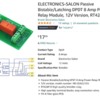GunnerRunner, thanks for your excellent simple-to-do solution. I just saw it a minute ago. I didn't see your reply yesterday because while you were posting it, I was looking at the DalleWebsite and then typing up my questions about the Dalle system and pressing POST. After posting it, I signed off until this morning.
Thanks to Stan and everybody else for the thoroughly informative answers.
I am going to use a small dedicated DC transformer, from an HO train, mounted under the table to power the handcar track, because it will run on a dedicated short track run. The transformer will cost about $5 used at the flea market. And, although I may fail, I think I'm going to try John's cheapest suggestion first. (Finding big and sensitive push buttons for the car to run into may be a challenge, especially since they will have to be mounted upright. May those standard ,cheap Lionel "big red buttons" in black plastic squares would work.
Thanks to the advice from all of you guys a year ago, I bought last year a pretty nice bridge rectifier, so if the HO transformer doesn't put out enough DC juice to power the car, I can try to power it with the old 1099 transformer that I already have mounted under the table (which I use to power my free standing steam whistle unit.)
Mannyrock


















